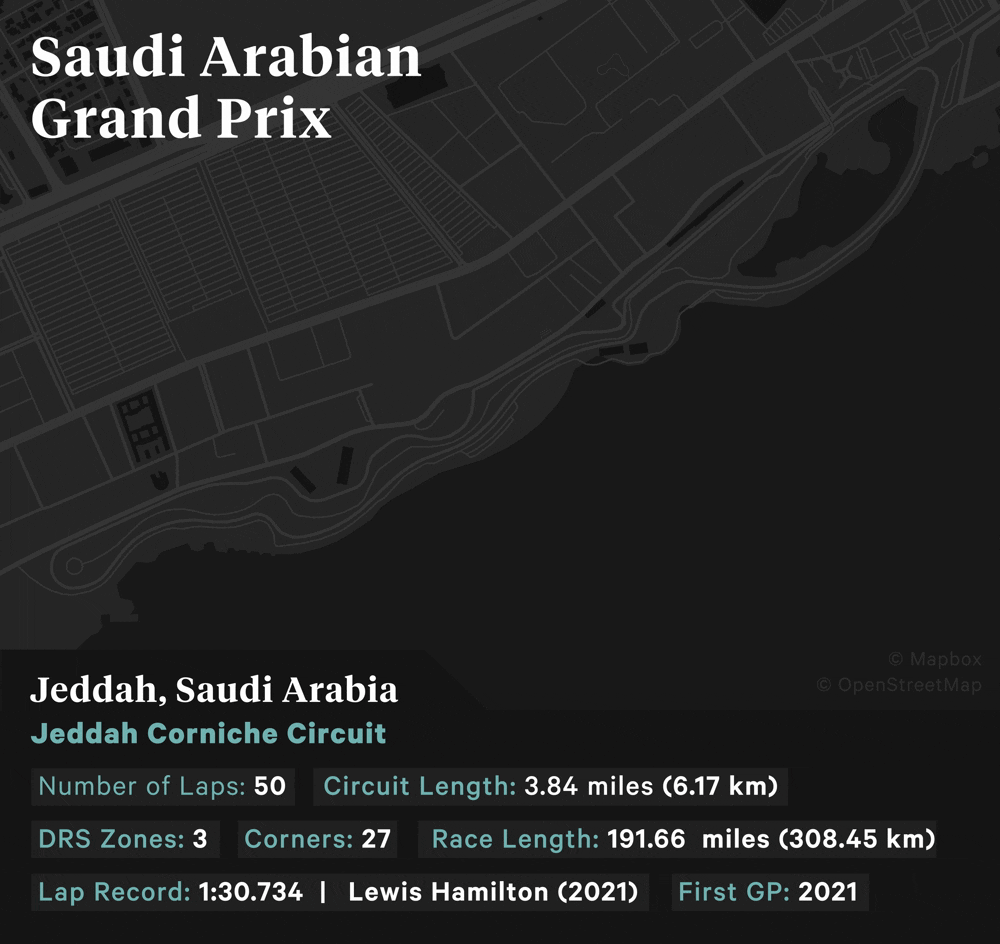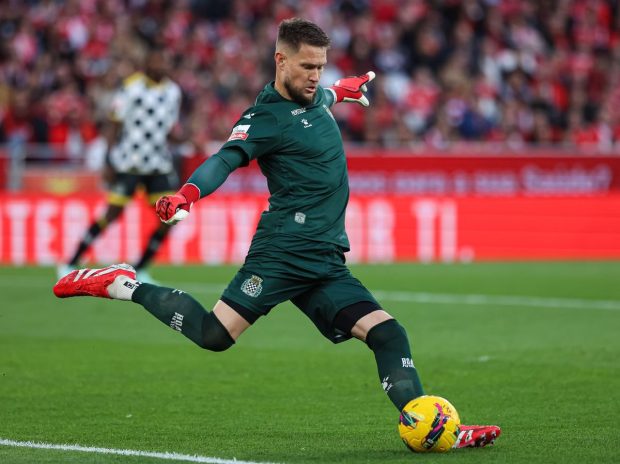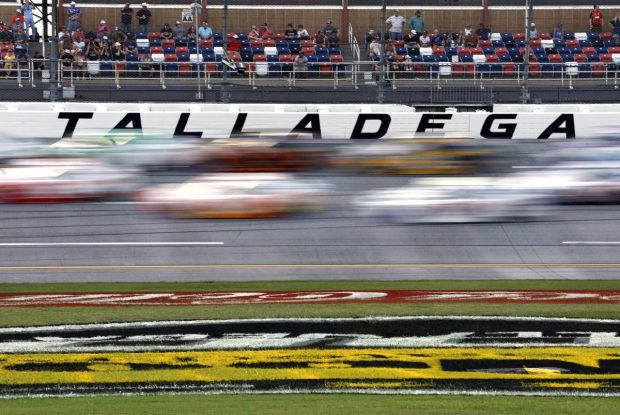
The end of Formula One’s first tripleheader of the season is here.
The paddock traveled around 1,600 kilometers (994 miles) this week, switching from Bahrain’s permanent track with an abrasive asphalt to Saudi Arabia’s high-speed street circuit. Jeddah Corniche Circuit does have some permanent components, but overall, it is a temporary track, located slightly northwest and just over 100 km (62 miles) from Mecca, on the Red Sea coast. It’s the second longest track on the calendar and has the most turns — 27.
Advertisement
Ferrari described the track in its 2024 preview as “a cross between Spa-Francorchamps and Monaco, being an ultra-high-speed narrow strip of asphalt in between the barriers where drivers rocket through at an average speed of around 250 km/h (155 mph).” According to Pirelli, the drivers “around 80% of the lap with the accelerator buried to the floor,” despite the track’s twisty layout.
Before we dive into round five of the 24-race schedule, here’s what you need to know about the Jeddah Corniche Circuit — and what you can expect this weekend.
Jeddah Corniche Circuit key specs

The track’s controversial history
The Saudi Arabian Grand Prix has been controversial given the country’s human rights record and the safety concerns raised during the 2022 race.
Prior to the inaugural race in 2021, drivers raised questions about human rights issues as F1 continued its expansion into the Middle East. Bahrain has been on the calendar since 2004, Qatar was added in 2021 alongside Saudi Arabia, and the season finale is in Abu Dhabi, whose Yas Marina Circuit had its first grand prix in 2009. Qatar and Saudi Arabia in particular have been accused of sportswashing, most notably with the 2022 World Cup.
During the first practice of the 2022 Saudi Arabian Grand Prix weekend, a missile fired by Yemeni Houthi rebels struck an oil plant several miles from the circuit. With smoke visible in the air, the drivers raised safety concerns about proceeding with the race and met with team principals and F1 representatives until the early hours of the morning on Saturday. This attack occurred two weeks after Saudi Arabia carried out a mass execution of 81 people convicted of an array of crimes.
Mercedes team principal Toto Wolff said the day after the missile strike that he felt F1 could “put the spotlight” on what is happening in the Middle East by racing there.
Advertisement
“I’d rather come here and make the spotlight shine on the region so it needs to be a better place rather than say I’m not going there and I don’t want to hear anything of it,” he said.
A new kind of street circuit
The street circuit is nestled in Corniche, a coastal resort area in Jeddah, on the Red Sea. Tilke, a name widely known throughout F1 for their track designs, was behind the creation of Jeddah Corniche Circuit. Using Google Earth to brainstorm possible track layouts, the company and F1’s motorsports team delivered not only one of F1’s fastest circuits, but one of the quickest built.
“We don’t want Mickey Mouse circuits,” Ross Brawn, F1’s former managing director for motorsport, said in 2021. “We don’t want those old classic street circuits with 90-degree turns. We want fast sweeping circuits, circuits which are going to challenge the drivers — and they are going to love it.”
Working to avoid the start-and-stop nature of a routine street circuit, they landed on an thrilling 27-turn layout, making it the track with the most corners on F1’s calendar. One corner is practically a U-turn. And while narrow street tracks like Monaco tend to limit overtaking options, there are points in Jeddah that give space for wheel-to-wheel racing like that seen between Charles Leclerc and Max Verstappen in 2022.
“It’s a really fun circuit,” Lando Norris said in 2023. “Exhilarating, fast.”
Twisty, speedy, and hopefully safer
If you want to satisfy your need for speed this weekend, look no further. Saudi Arabia’s circuit is known for its speed with cars averaging around 250 km/h (155 mph), making it the second fastest track on the calendar behind Monza.
Going that fast through the turn-heavy track along the Jeddah waterfront requires precision from the 20 drivers, and mistakes are common. The young track already has a reputation for causing crashes, such as Mick Schumacher’s heavy collision with the wall during qualifying in 2022 that sent him to the hospital “for precautionary checks.” He was released soon after but did not compete in the race.
After discussions between the drivers, F1 and the FIA, several safety-minded changes were made to the track layout ahead of the 2023 grand prix, including:
- Walls moved to improve visibility on Turns 8, 10, 14 and 20.
- Rumble lines added at Turns 3, 14, 19, 20 and 21 in an effort to help keep drivers within track limits. These are similar to the grooves on the side of the highway that give you a buzz when you stray onto the shoulder.
- The chicane at Turns 22 and Turn 23 was tightened, which is expected to lower the speed through this portion.
- The track’s particularly high and steep kerbs have been lowered, limiting the risk that a driver who runs wide loses control of their car (as Schumacher did in 2022, leading him to slam into the concrete wall).
Let’s talk strategy
Pirelli changed its approach this year. After keeping the same tire compounds as 2024 throughout the first four race weekends, Pirelli went softer for Saudi Arabia.
As a reminder from our tire explainer: Softer tires have more grip (which is vital to getting through corners fast) but don’t last super long. Hard tires have less grip at first as they get to temperature, but have the longest life. These are numbered C0 (the hardest and most durable) through C5 (the softest and fastest).
Advertisement
The three tire compounds this year will be C3 as the hard tire, C4 as the medium, and C5 will be the soft. Over the last four years, the one-stop strategy has been the team’s preference and most effective option, even when a safety car period happens. Valtteri Bottas was the only driver who did a two-stop race last year.
The choice of compounds for the first four races of this season were the same as last year’s, but for round five, Pirelli has taken a softer step, with the C3 as Hard, the C4 as Medium and the C5 as Soft being the trio available in Jeddah. Read more 👉https://t.co/WRUyU8cYpo #F1 pic.twitter.com/WSrH38VdkC
— Pirelli Motorsport (@pirellisport) April 15, 2025
Having the softer tire compounds “is in line with the aim, shared with the FIA, F1 and the teams, to create more strategy choices for the race and therefore more exciting and unpredictable racing,” Pirelli said in its 2025 race preview.
“We’ve seen in the past that sometimes the very soft tires are a little bit different the way that they feel in high-speed corners, and this weekend is definitely a high-speed track,” Alex Albon said during Thursday’s FIA news conference. “So it will be interesting to know how we can get the C5s working this weekend. I think as it has been every weekend so far, the tires are very sensitive, and if you can get them in the right window, it’s the difference maker. I think all the cars now in the midfield are so close together that if you’re in that right window, that’s Q3.”
Overtaking is difficult, the most likely spot being at the entry of Turn 1, and the likelihood of a safety car or red flag is higher due to the scarcity of run-off areas on the Jeddah street circuit. Qualifying matters even more this weekend because of the grid position.
What the drivers are watching
- Track evolution: All tracks get faster as the race weekend goes on, because the cars steadily sweep away any dirt or sand and lay down rubber, both of which improve traction, letting everyone take corners faster. Because Jeddah’s a night race, drivers must also watch for how temperature changes from daytime practice sessions to evening qualifying, and racing changes conditions. “Track evolution is huge,” Nyck de Vries said in 2023. “You have your first practice still at relatively hot temperatures, and the track is constantly improving.”
- No room for mistakes: The high-speed, turn-heavy course leaves little margin for error, but taking it easy just won’t do. “Every lap you just have to go for it, especially the last attempt in Q1 and also the last one in Q2,” Zhou Guanyu said in 2023. “Especially here with the high-speed, with the wind it could be a bit tricky.”
(Lead image: Clive Mason & Mark Thompson/Getty Images; Design: Eamonn Dalton/The Athletic)
(Track graphic: Drew Jordan/The Athletic)
This news was originally published on this post .










Be the first to leave a comment